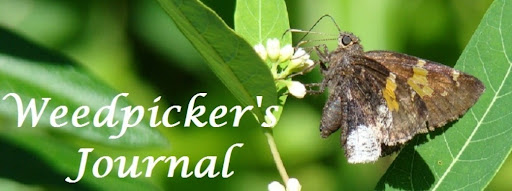One of the most fascinating plants on the Point Pelee trips was this Gooseberry. After spending hours in the books, I can officially say I know quite a bit more about the individual species enough to say one thing:
YIPES Ribes! These species are maddeningly difficult to key out.
OK, maybe I know two things. Not only does it take a true botanist to sort these bad boys, there are many species around, some of them non-natives. Should we just totally avoid them? I don't think so, but maybe it is OK to just note they are one of the Ribes. They are quite interesting, and provided a great case study in the relationships of birds and flowering plants.

This is the Gooseberry in question from Point Pelee. I am fairly confident it is
Bristley Gooseberry, Ribes cynosbati.However, I am
only confident because that is how it is listed on the FLORA of Point Pelee, a handy little list I will take on my next visit to Canada! Click
on this and scroll to the bottom of the page for their complete listing.
Note: it may cause some confusion that the list is broken down into
monocot and
dicots, and Large-flower
Bellwort is list as simply "
Bellwort."
 But why were we so interested in Bristley Gooseberry?
But why were we so interested in Bristley Gooseberry? Because it was a bird magnet.
This Tennessee Warbler was
nectaring on the flowers, entertaining us for the longest time as it popped about acrobatically. A lucky moment finally revealed the tell-tale eye line.
Most of the time, it would have done
Dave Lewis proud- only giving us views of its underside.
This Tennessee was not the only bird in this bush, I first started watching this gooseberry when an Orchard Oriole had flown in to sip on the flowers. In the half-hour or so we watched it during lunch, several other species came by for their lunch- including a Ruby-throated Hummingbird.
 Trip leader Dan Donaldson (standing center)
Trip leader Dan Donaldson (standing center) called out many species to an appreciative crowd. The gooseberry bush was just beyond this railing where we enjoyed our very
birdy lunch.
Thanks to BSBO for scheduling this boat trip to a foreign land, filled with interesting birds and plants. The talented leaders on these trips make it fun to see and savor so many species in a short amount of time. And while the Magee Marsh boardwalk remains a great place to see warblers- and gooseberries- there are plenty of other interesting trips and locations offered at The Biggest Week. I hope you will try a few of them next year.
Thanks to Kim and Delores for allowing me to help
BSBO in any little way I could, and a huge tip-of-the-hat to all the fabulous birders and leaders I enjoyed rubbing shoulders with through out the week, especially Greg Miller. And many thanks go to the
Tropical Birding guides who helped at least a thousand people see their first Connecticut Warbler!
What an incredible 10 days it has been!
 American Copper butterfly on a Hawkweed. Both are considered non-native species- but who cares? Sometimes you just have to appreciate a beautiful spring day and the spectacular colors.
American Copper butterfly on a Hawkweed. Both are considered non-native species- but who cares? Sometimes you just have to appreciate a beautiful spring day and the spectacular colors. Judy Semroc from the Cleveland Museum of Natural History was concentrating on interesting insects and possible salamanders in this clear running stream.
Judy Semroc from the Cleveland Museum of Natural History was concentrating on interesting insects and possible salamanders in this clear running stream. Do you recognize this well-known wetland flower? It is the seed pod from Marsh Marigold, Caltha palustris. The delicate green orbs hold a million miniature seeds just on the brink of spilling into the stream.
Do you recognize this well-known wetland flower? It is the seed pod from Marsh Marigold, Caltha palustris. The delicate green orbs hold a million miniature seeds just on the brink of spilling into the stream. Showy Orchis, Orchis spectabilis.
Showy Orchis, Orchis spectabilis.












































